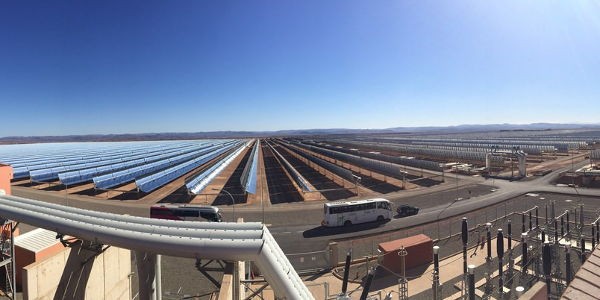Desert solar farms in Morocco
The Government of Morocco initiated the development of a giant solar power plant, by setting up a public-private partnership with independent power producers. By supporting technology adopters the partnership enabled the procurement of eco-innovation in the shape of pioneering concentrated solar power (CSP) technology. The Noor plant has a capacity of 580 MW and will go a long way to helping Morocco achieve its goal of 42% renewable energy penetration by 2020.

The challenge:
Like many countries Morocco has a low penetration of renewable energies and is reliant on imports for the majority of its energy supply – more than 95% at the beginning of this decade. The Kingdom developed a new energy strategy in 2009, with the primary objectives to (a) diversify and optimise the energy mix to reduce oil expenditure by 40% by 2030 and (b) develop the national renewable energy potential.
The measure:
The Government of Morocco is exponentially increasing its renewable energy capacity by building a giant 580 MW solar power complex in the desert region of Drâa-Tafilalet.
The project was initiated by the Moroccan Agency for Solar Energy (MASEN), and is split into four phases. Phase one of the project involved the construction of a 160MW concentrated solar power (CSP) plant named Noor I.
A public-private partnership was created to realise Noor I. The partnership was made up of developers (ACWA power, Aries and TSK), engineering, procurement and construction contractors (Acciona, Sener and TSK), who developed the project on a build, own, operate and transfer (BOOT) basis. MASEN entered power purchase agreements (PPAs) to off-take the entire output.
Noor I came online in 2016. Noor II, III and IV are scheduled to open in 2018.
Rather than ‘traditional’ photovoltaic panels, the plants use concentrated solar power (CSP). Mirrors focus solar energy onto pipes, which are used to heat water and produce steam. This method offers the possibility to store energy without batteries, meaning production can continue around 20 hours a day.
MASEN exploited a number of sources to finance the project. This included debt funding from the African Development Bank (AfDB) Group, the Agence Française de Développement, the Clean Technology Fund, the European Commission, the European Investment Bank, Kreditanstalt für Wiederaufbau and the World Bank.
Through the development of this and other projects, Morocco is on track to meet 42% of national energy demand through renewable energies by 2020. Noor I alone offsets 240,000t a year of CO2 emissions, and generated approximately 1,000 temporary (construction) jobs and 60 permanent jobs.
Lessons learnt:
MASEN exploited an innovative financing structure, setting up synergies with independent power producers to sell the power generated by the plant back to the government in a public-private partnership arrangement.
The CSP technology used has limited demonstration, especially not at this scale, so support from the Moroccan government and international institutions – both in terms of financing and technical assistance – was critical to the success of the project.
Further deployment:
Morocco has been a pioneer in large-scale renewables projects and other countries should be inspired to initiate their own. GML 8
Links:
https://en.wikipedia.org/wiki/Ouarzazate_Solar_Power_Station
https://www.nrel.gov/csp/solarpaces/project_detail.cfm/projectID=270
https://www.afdb.org/en/projects-and-operations/selected-projects/largest-concentrated-solar-plant-in-africa-reducing-moroccos-dependency-on-external-power-137/
